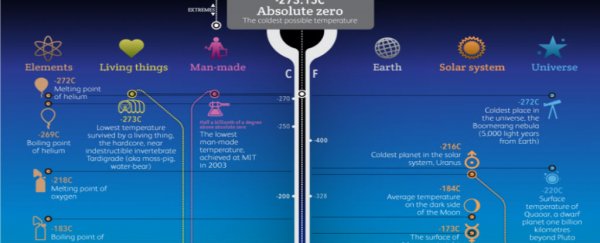How cold is the coldest place in the Universe, that we know of? What's the lowest man-made temperature ever achieved?
And just how many zeroes are needed to express 'absolute hot', after which the fundamentals of conventional physics start to break down in all kinds of strange ways?
All is revealed in this awesome infographic created by BBC Future back in 2013.
Most people are pretty familiar with absolute zero, it's -273.15 degrees Celsius (-459.67 degrees Fahrenheit), and it's the lowest possible temperature that can ever be achieved, according to the laws of physics as we know them.
This is because it's the coldest an entity can get when every single skerrick of heat energy has been sucked right out of it.
Even the coldest known object in the Universe - the creepy-looking Boomerang Nebula - isn't as cold as absolute zero. Just look at that thing.
But what about absolute hot? It's the highest possible temperature that matter can attain, according to conventional physics, and well, it's been measured to be exactly 1,420,000,000,000,000,000,000,000,000,000,000 degrees Celsius (2,556,000,000,000,000,000,000,000,000,000,000 degrees Fahrenheit).
Which, of course, is ridiculous. The only thing that we know of that's ever come close to absolute hot is the temperature of the Universe, at 104 seconds old.
Way back up on the infographic is our biggest achievement in the heat stakes: 5,500,000,000,000 degrees Celsius (9,900,000,000,000 degrees Fahrenheit), which scientists were able to achieve by crashing lead ions against each other in Switzerland's Large Hadron Collider.
There's so much more fascinating stuff on this infographic, you can find out the temperature of the clouds on Jupiter, the average January temperature in the coldest place on Earth, and the temperature inside a conventional chemical bomb.
Thank you, science.
(Click here for an even bigger version.)

